Billiard/Snooker Table Beds
Prior to 1826 Billiard tables
(when I mention a billiard table you can substitute the word
Snooker!!) had wooden beds. These beds were by no means level and
it is recorded that Thurston sent out their fitters to 'flog' the
bed i.e. they went and tried to plane off the high spots. An
example of a full size wooden bed is in the Collection and there is
also an 8ft portable table with a wooden bed.
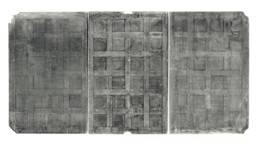
Full size wood bed ,
showing both playing surface and underside of the
sections
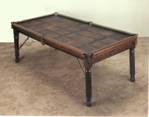
Thurston 8ft. portable Billiard
table with wood bed
There is evidence that experiments were being carried out in to
materials to replace the wood beds as a table that Thurston has in
stock circa 1820 has a concrete type bed which has a wood surround
so that the cushions can be bolted on. The table is either a Gillow
or and early Thurston based on the leg style .
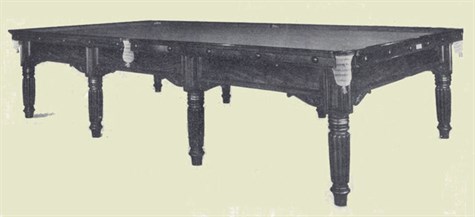
Table No. 11556 which has a
composition/concrete bed with wood surround. (This table is
currently [2012] in Thurston's stock of antique tables ready to be
refurbished)
However slate proved to be the most suitable as the both the top
and base surfaces could be worked smooth, it was relatively easy to
fit the cushion nuts into the depth of the slate and also to drill
holes through it to secure the slate lining. The original slate
beds tended to be of similar thickness as the wood beds they
replaced which meant they were about 1 inch (25mm). This meant that
the slates required greater support as this thickness meant they
could easily go hollow.
The problem with these thin slates was
brought to the attention of players once rubber was used in the
cushions especially when they were compared to tables that had the
thicker slate beds. The reason was that the thin slate did not give
sufficient support to the cushion. In other words the cushions were
not solid on to the slate and so when the balls struck the cushion
some of the impact was absorbed by the cushion moving. The answer
was either to fit new slates, an expensive job, or to fit the newly
patented 'steel block' cushions ( 1886) or the Thurston 'Adament
'cushion. These cushion being heavy gave a solid foundation for the
cushion rubber and so the response from the such cushions improved
the playing characteristics of the table without the necessity of
replacing the slates.
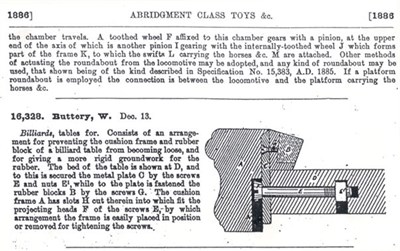
Thurston 'Adament' Cushion with
a slate in fill to body

Interestingly it seems that the Bangor
slate from the Penryhn quarries was held in high esteem as two
mentions in catalogues extol its virtues.
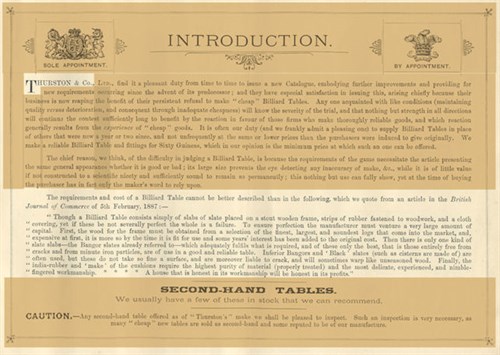
From the Thurston booklet "The Noble Game of Billiards"
published in 1908 - the following is an extract - "Within the
spacious yard one sees the ponderous slabs (sic slate) in mighty
stacks awaiting their turn to entre the busy shed where their
uneven surfaces shall be smooth, and their rough places plain. Many
soft and friabble slate are found in this country which are freely
used in the construction of cheap billard tables. The slates which
command the highest price in the market by reason of their density,
hardness, and uniformity, are those from Lord Penryhn's quarries at
Bangor, and Thurston's is the only Billiard firm supplied
direct".
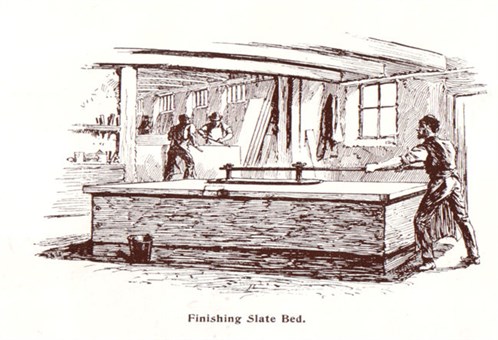
The early Welsh slate as described
seems to need a fair bit of work to be carried out on it once it
was delivered to the Billiard works and 'floating' the slates was a
common requirement. This involved pushing and pulling a heavy steel
open latices device back and forth across the surface. As shown in
the picture below.
In fact even up to the late 1980's
Thurston still 'floated' some new slates - the reason being that if
the slates were shipped before they had fully seasoned the slate
sometimes moved slightly and so the 'floating' ensured that there
was no lipping at the joints. The floating in the 1980's involved
using a special non silica compound as the abrasive and a lot of
hard work pushing the float back a forth whilst ensuring that it
was done evenly.
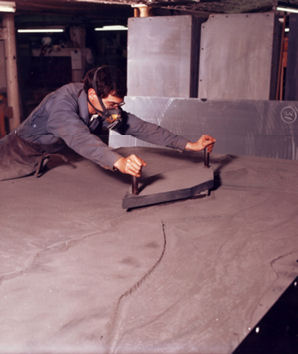
R. Campbell hand floating a Full
Snooker Table
Over the years the slate thickness was increased until an
optimum that gave rigidity and stability but without making the
slabs so heavy as to be impossible to move meant that the modern
slates are 1 ¾ inches thick (45mm).
It seems that between WWI and WWII the slate demand being less
meant that cheaper sources of suitable slate were examined and so
Italian slate became the norm for table beds right up to the late
1990's. It is also suggested that as Welsh slate was harder that
Italian and was still blasted out of the quarries they couldn't
control the size of the pieces whereas the Italian slate could be
cut out of the quarries and thus the sizes could be more readily
controlled, meaning less waste. I also understand that in general
the Welsh slate used for Billiard tables was a type of slate
unsuitable for roofing slate as it would not cleave and so was to
some extent considered to not be worth mining when demand fell
after WW I.
As previously mentioned since the 1930's most slate used in
Billiard / Snooker tables has been Italian slate and they supplied
not only the UK market but also the World market for slate for all
the Billiard games. So the Italian quarries invested in machines to
improve the production and quality of the slates they supplied. The
following pictures are taken from Italardesia catalogue
circa 1982.
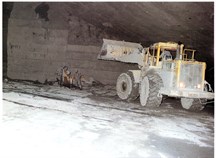
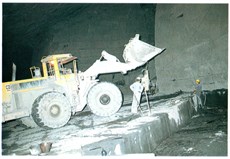
talian slate is quarried from
vast underground layers. The slate veins lie between two sandstone
layers making up the floor and roof. The slate veins are cut into
to mmake blocks of different sizes as required for the different
demands.
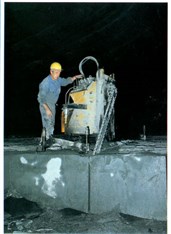
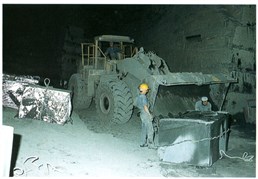
Aspecial hydraulic chain saw cuts
the blocks out of the layer. The blocks are extracted by a huge CAT
and taken out of the quarry. The blocks must be kept moist and so
are wrapped in plastic until they are sawn. It is important to
protect the blocks from drying out, otherwise they become brittle
and are useless.
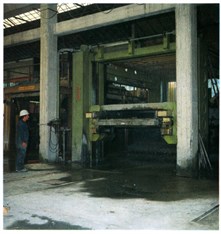
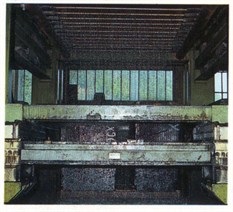
Slate finishing is a multi stage
process. The first stage is cutting the blocks with a gang saw.
Each gang saw can have 10 to 25 diamond toothed long blades. The
second picture shows a close up of a block being sawn. The
gang saw can handle blocks up to 9ft. long by 6ft wide. The slabes
are cut approx. 1/8th inch thicker than desired finished
thickness.
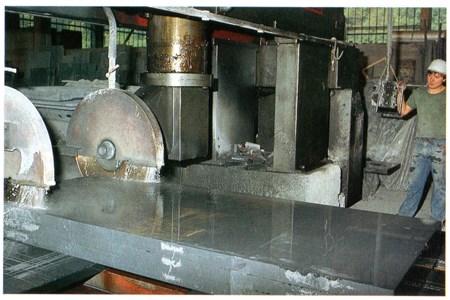
After a first curing period the
raw slabs are cut to the exact size desired by computerised sawing
machines. Both sides of each batch of slabs are cut at the same
time by twin circular saws, so as to ensure perfectly parallel
cut.
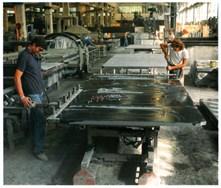
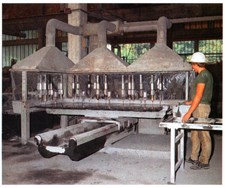
The trimmed sections are now
assembled together into a complete set of billiard slates in order
to fix dowles, drill screw holes and bolts holes for a full sized
snooker table. Sections of the slates are drilled automatically
after being assembled as a complete set, in order to ensure
accurate location of the holes as per specifications.
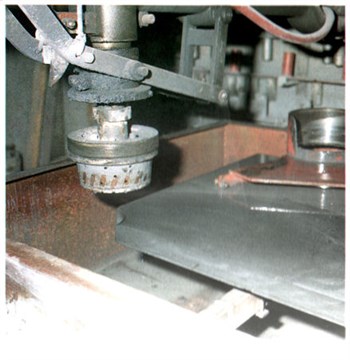
Pockets must be cut one by one with
diamond teeth bits, which have the required angle leaving the edges
of the pockets smoothly rounded off.
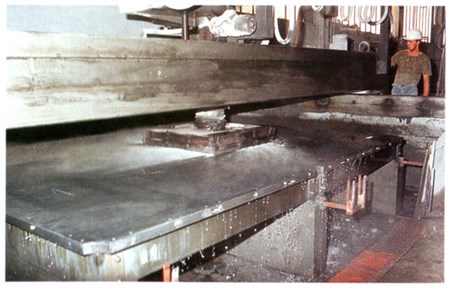
The set complete with dowles,
pocket openings, bolts etc. is then carefully 'floated' to obtain
the perfectly flat, smooth surface required for the game.
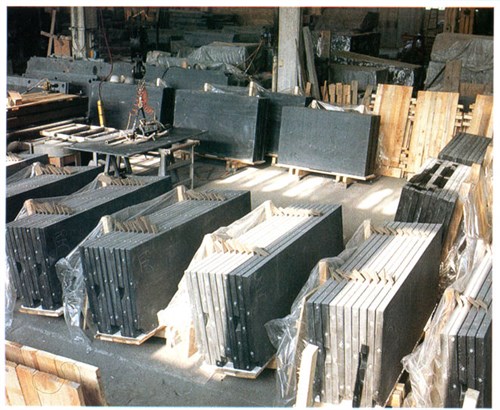
Slates waiting final inspection
before packing
The most important step after floating
is the final curing process which last for several weeks. Until the
slate is perfectly dry. Before packing the slate is again checked
and only a perfect product leave the factory.
When there was a spike in the demand for Snooker tables in the
late 1980's early 1990's the price of slate went up quite
dramatically as production was not able to keep up with the demand.
So other materials were again tried, for example float glass was
used for a time by Rex Williams leisure inn their UK Pool Tables.
It did not prove successful and a more recent example of such a
glass bed is in the collection. Other material were tied such as
resin and granite, resin and slate dust but such beds faced two
main problems the thickness to size of slab proved to be a problem
also whilst it was possible to get one good surface it didn't seem
practical from a cost point to achieve both the top and back
surfaces to be smooth and level. So despite many attempts no
replacement for slate was found.
In more recent years cheaper slate has been sourced from China
but when used in the championship tables they have selected a 2
inch (50mm) slate. It could be that they need the extra thickness
to ensure that it stays flat as the extra weight will make handling
and delivery more difficult. In Europe the Carom Billiard tables
have for a long number of years had a 50mm thick slate but the
slabs are smaller and therefore are easier to handle than a 50mm
Full size Snooker table slab.
acknowledgement - Italardesia - for pictures
and descriptions of processes
© E.A. Clare & Son Ltd.
2022. © Peter N. Clare 2022
Reproduction of this article allowed only with the permission from
E.A. Clare & Son Ltd.
thurston.co.uk - the e-shop for all your Snooker, Pool
& Billiard equipment
or Just
call +44(0)151 482 2700 or visit
www.thurston.co.uk
******************

